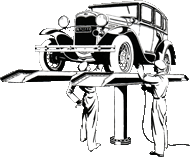
1930 Model A Coupe
Model A Ford Garage
Trunk Compartment Construction
The following pics show how the various trunk panels are arranged on a 1930 coupe body. The panels are shown assembled with screws during fitting, and those requiring rivets were later installed after stripping, e-coat priming, and reassembly.
Panels are just mocked up in position with screws in these pics, not riveted. I had to rebuild the rear quarters and the entire bottom 2 inches of the body. It's a combination of original, reproduction, and hand fabricated panels. Hole locations were either laid out per original Ford detail drawings, or were carefully transferred from original parts.

 fordgarage.com
fordgarage.comGeneral arrangement, drivers side. This view also shows the hole and wear plate in the upper rain gutter for mounting the trunk support arm bolt which the slider arm engages.

 fordgarage.com
fordgarage.comThis is a plan view of the drip rail passing through the curved trunk panel. This is similar but different than a curved rumble panel. Drivers side.

 fordgarage.com
fordgarage.comClose-up of the junction of the panels. Drivers side.

 fordgarage.com
fordgarage.comUnderside long view of the panels. Looking towards drivers side.

 fordgarage.com
fordgarage.comThis is an underside view of the rear tire support braces, and the original reinforcements for the under trunk lid panel. Looking towards drivers side. See the Panel Fabrication page for details on the outer panel.

 fordgarage.com
fordgarage.comView showing the forward end of the tire support brace sandwiched between the trunk floor riser and the curved inner panel. Looking towards drivers side.

 fordgarage.com
fordgarage.comClose-up underside view of the panels showing the trunk drip rail extending through. Looking towards drivers side. The brown triangular reproduction piece required quite of bit of rework to match the Ford part drawing dimensionally.

 fordgarage.com
fordgarage.comThe brown brace is just propped up. It installs in the approximate location shown. This reproduction part required complete rework of the bottom shape and hole locations to match the Ford part drawing.

 fordgarage.com
fordgarage.comUpper trunk corner showing panel overlap and rivet location. The trunk hinge pivot bolt hole is also seen in this pic.

 fordgarage.com
fordgarage.comThis is the trunk lid hinge pins and mounting brackets which are attached at the upper hole locations of the opening using flat head screws and hex nuts.
More 1930 Model A Ford Coupe Web Pages:
- For more Model A & B related information, use the Site Search box at the top or bottom of this page.
- Quarter Panels Before Restoration
- Sub Rails Before Restoration
- Trunk Lower Panel Fabrication
- Roof Wood Construction
- Body Assembly
- Coupe Seat Belt Installation
- Coupe Body Measurements
Vince Falter
January 2000

